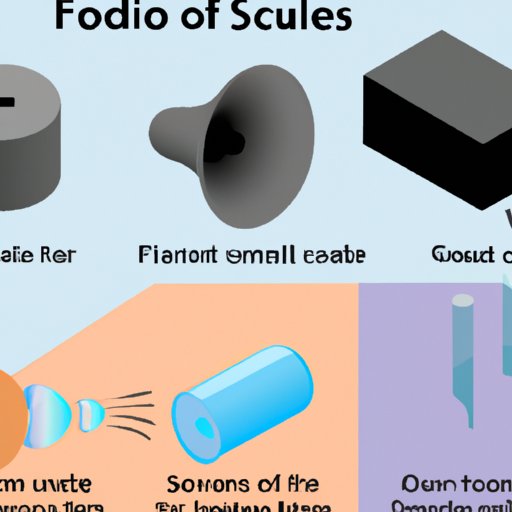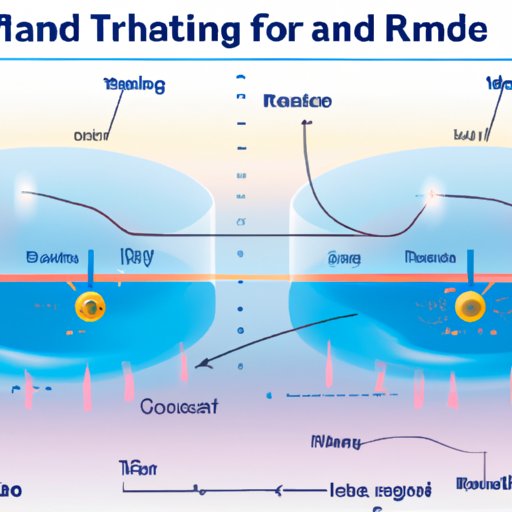Introduction
Sound is an energy wave that can be heard when it reaches a person’s ear. It is created by vibrating objects and travels through a medium such as air or water. Sound waves are complex, and understanding how they move through different mediums can help us better understand their behavior. In this article, we will explore what sound can travel through, looking at air, water, and solid objects.
How Sound Travels Through Air
In order for sound to travel through the air, it needs molecules to vibrate. These molecules are set in motion by the source of the sound, causing them to bump into each other and pass along the vibration. The molecules then spread out in all directions, creating a pressure wave that moves outward in ever-increasing circles.
The basic principles of sound propagation in air are fairly straightforward. However, there are several factors that can affect how sound travels through air. These include temperature, humidity, wind, and altitude. For example, warm air is less dense than cold air, so sound will travel more quickly and with greater intensity in warmer conditions.

How Sound Travels Through Water
Sound travels much faster through water than through air. This is because water molecules are denser than air molecules, allowing them to carry the sound waves more effectively. When sound waves enter the water, they cause particles to vibrate and move, creating pressure waves that propagate through the water.
Just like with air, there are several factors that can affect how sound travels through water. These include temperature, salinity, depth, and pressure. For instance, sound waves move more slowly in colder water and faster in warmer water. Additionally, sound waves can be reflected, refracted, and diffracted depending on the density of the water.

How Sound Travels Through Solid Objects
Sound also travels through solid objects, though the process is slightly different than with air and water. When a sound wave strikes a solid object, it causes the molecules of the object to vibrate. This vibration is then transferred through the material, creating pressure waves that move in all directions.
The speed at which sound travels through solid objects depends on the material’s density and elasticity. Harder materials such as steel and concrete will transmit sound more quickly than softer materials such as wood and cloth. Additionally, the shape and size of the object can also affect how sound waves travel through it.
Investigating the Physics of Sound Travel
In order to better understand how sound travels through various mediums, it is important to look at the physics behind sound. Sound is made up of waveforms and frequency. Waveforms represent changes in air pressure, while frequency is measured in hertz (Hz) and indicates the number of sound waves per second.
The speed of sound is determined by the medium it is traveling through. For example, sound travels faster in air than in water. This is due to the amount of energy required for the molecules in each medium to vibrate. Additionally, sound can be affected by reflection, refraction, and diffraction, depending on the shape and density of the medium.

Exploring the Different Mediums Sound Can Travel Through
We have already discussed how sound travels through air, water, and solid objects. However, there are other mediums that sound can travel through as well. These include gases, liquids, and plasmas. Additionally, sound waves can also be transmitted through electrical and magnetic fields.

The Impact of Temperature on Sound Travel
Temperature is one of the most important factors in determining how sound travels. As we have seen, warm air is less dense than cold air, so sound will travel more quickly and with greater intensity in warmer conditions. Additionally, temperature can also affect the speed of sound.
According to research conducted by The Acoustical Society of America, “For every 1°C increase in temperature, the speed of sound increases by 0.6 m/s.” This means that sound will travel faster in hotter environments than in cooler ones.
Temperature can also affect the intensity of sound waves. In general, higher temperatures will result in louder sounds, while lower temperatures will result in quieter sounds.
Examining the Effects of Vibrations on Sound Travel
Vibrations can also have an effect on sound propagation. One of the most common examples of this is resonance, which occurs when a sound wave matches the natural frequency of an object. When this happens, the sound wave is amplified, resulting in a louder sound.
On the other hand, vibrations can also lead to absorption, which occurs when the sound wave is dampened by the object it is traveling through. This can happen if the object has a porous surface, such as foam or insulation. In these cases, the sound wave will be weakened as it passes through the material.
Conclusion
In conclusion, sound can travel through air, water, and solid objects. Understanding the basic principles of sound propagation, as well as the factors that can affect it, can help us better understand its behavior. Additionally, we must consider the physics of sound travel, including waveforms, frequency, and the speed of sound. Finally, temperature and vibrations can both have an effect on how sound travels.
These are just some of the topics related to sound travel that warrant further investigation. As technology continues to evolve, so too does our understanding of how sound behaves in different mediums. With this knowledge, we can continue to improve our ability to control and manipulate sound for a variety of applications.
(Note: Is this article not meeting your expectations? Do you have knowledge or insights to share? Unlock new opportunities and expand your reach by joining our authors team. Click Registration to join us and share your expertise with our readers.)
